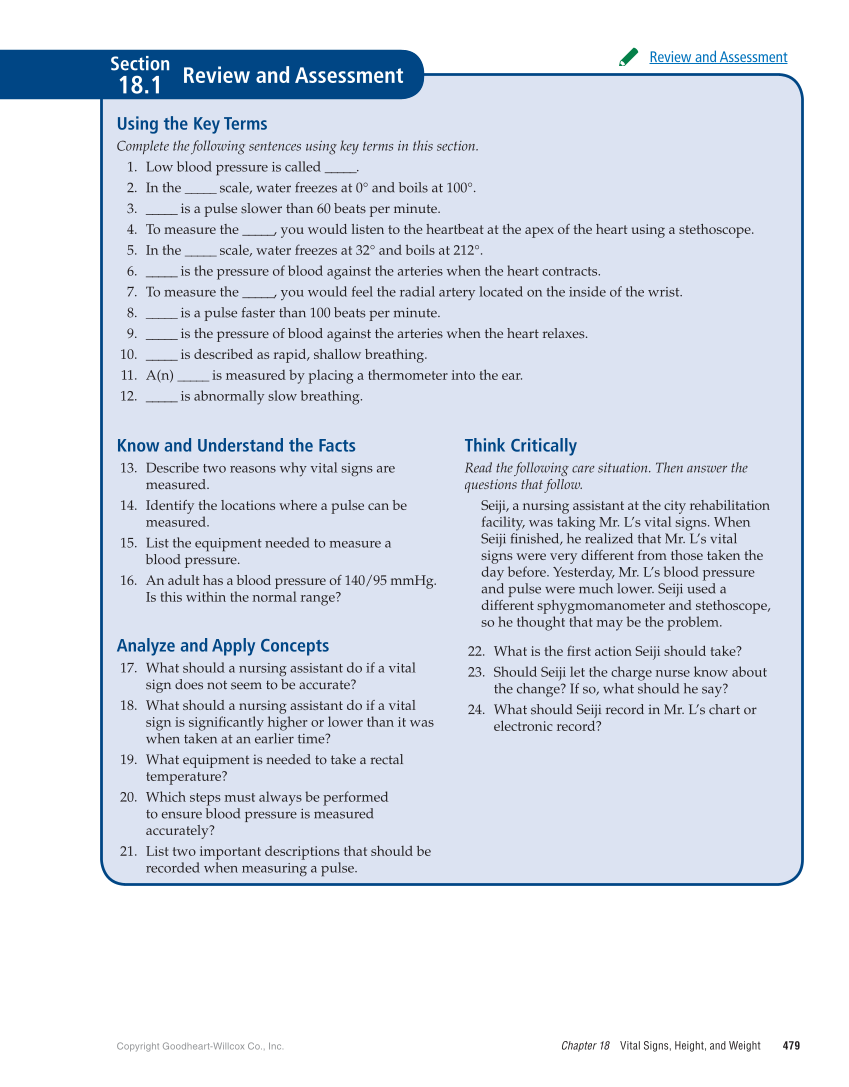Copyright Goodheart-Willcox Co., Inc. Chapter 18 Vital Signs, Height, and Weight 479 Know and Understand the Facts 13. Describe two reasons why vital signs are measured. 14. Identify the locations where a pulse can be measured. 15. List the equipment needed to measure a blood pressure. 16. An adult has a blood pressure of 140/95 mmHg. Is this within the normal range? Analyze and Apply Concepts 17. What should a nursing assistant do if a vital sign does not seem to be accurate? 18. What should a nursing assistant do if a vital sign is significantly higher or lower than it was when taken at an earlier time? 19. What equipment is needed to take a rectal temperature? 20. Which steps must always be performed to ensure blood pressure is measured accurately? 21. List two important descriptions that should be recorded when measuring a pulse. Think Critically Read the following care situation. Then answer the questions that follow. Seiji, a nursing assistant at the city rehabilitation facility, was taking Mr. L’s vital signs. When Seiji finished, he realized that Mr. L’s vital signs were very different from those taken the day before. Yesterday, Mr. L’s blood pressure and pulse were much lower. Seiji used a different sphygmomanometer and stethoscope, so he thought that may be the problem. 22. What is the first action Seiji should take? 23. Should Seiji let the charge nurse know about the change? If so, what should he say? 24. What should Seiji record in Mr. L’s chart or electronic record? Using the Key Terms Complete the following sentences using key terms in this section. 1. Low blood pressure is called _____. 2. In the _____ scale, water freezes at 0° and boils at 100°. 3. _____ is a pulse slower than 60 beats per minute. 4. To measure the _____, you would listen to the heartbeat at the apex of the heart using a stethoscope. 5. In the _____ scale, water freezes at 32° and boils at 212°. 6. _____ is the pressure of blood against the arteries when the heart contracts. 7. To measure the _____, you would feel the radial artery located on the inside of the wrist. 8. _____ is a pulse faster than 100 beats per minute. 9. _____ is the pressure of blood against the arteries when the heart relaxes. 10. _____ is described as rapid, shallow breathing. 11. A(n) _____ is measured by placing a thermometer into the ear. 12. _____ is abnormally slow breathing. Review and Assessment 18.1 Section Review and Assessment
